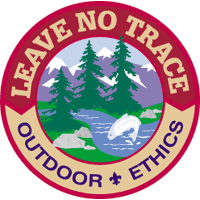
Durable Surfaces
Campsite Selection
Demonstrate the value of proper campsite selection.
Goal
Participants will evaluate appropriateness of various campsites and choose the best fit available.
Time
20 minutes.
Objectives
Participants will be able to:
- identify established campsites
- choose a campsite appropriate for their size group and minimizing their impact.
- understand the importance of choosing campsites correctly.
Materials
- 1 copy of Durable Surfaces Worksheet #4 for each group
Motivator
When camping in popular areas, there may be multiple campsites from which to choose. By scouting out the choices and choosing a best-fit location, you will minimize your impact as well as other groups. Arriving at your daily destination early helps increase your choices.
Presentation
- Hand out Durable Surfaces Worksheet #4
- Explain that your group is backpacking through a very popular wilderness where there are no regulated campsites, but many ad-hoc sites. People can camp any place they want and campfires are allowed, but the most beautiful spots are beginning to get over-used.
- With about 2 hours until sunset, your trail opens from the south into this meadow area. The next 2 and a half miles of trail is over very rocky ground with no water available. There are currently no other people camping here, but you know there is a group of 6 people following you and you overtook an older couple about a half hour ago. Both groups will most likely stop in this area for the night.
- You set down your packs and take a few minutes to check out the 5 sites around the meadow and this is what you find:
- NorthWest - highly used site with campfire ring and 1 obvious tent site.
- NorthEast - very highly used site with campfire ring and at least 3 tent sites. Lots of wear on the ground around the site and down to the water. The trees have all their lower limbs broken off.
- Center - a faint trail that leads to an area where you notice a few pieces of old burned wood and some matted grass.
- SouthEast by Lake - highly used site with 2 tent sites and ashes but no rock firering.
- SouthEast - established site with room for possibly 3 tents and a small campfire ring.
- Decide where your group will camp for the night and be prepared to defend your choice.
Reflection
- Ask a spokesman from each group to show where they decided to camp and give their reasoning.
- Some possible Pros and Cons for the sites:
- NorthWest - good location, farthest from water, but placing 2 tents would start expanding the site. Maybe leave this for the older couple.
- Center - poor location, since it is lightly used leave it to recover. No one should use this spot.
- SouthEast by Lake - too close to water, fits our group, highly impacted already.
- SouthEast - too close to trail, fits our group easily, already impacted.
- NorthEast - probably the best location, on edge of forest, off the trail, away from water, already highly impacted, but bigger than we need. We would be better positioned for leaving in the morning.
- If we don't take the spot too close to the lake and someone else does, will that result in more damage? (since we know LNT, maybe we will be more careful than the other groups.)
- Is it worse to be close to water or close to trail?
- If we are entering from the south and we take that first spot, could we help the next groups by letting them know we noticed sites that might work for their group? Thus, we could direct people away from the shore spot and the recovering spot.
- There are many trade-offs whichever site you choose. That is why Leave No Trace is an interpretive set of ethics rather than a rulebook.


